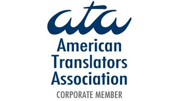| What translation technology does Rosetta Translation use? | We use the most sophisticated translation memory and data mining tools. More . |
| How do Rosetta’s translation memory tools work? | They ‘remember’ translations of segments for efficient future use. More . |
| How do Rosetta’s data mining tools work? | They allow database storage and use of previously created material. More . |
| How is this technology integrated into the Rosetta workflow? | With the client’s permission, we create a designated terminology database at the time of the first translation. All subsequent work expands and embeds this database further. More . |
| How does my organisation benefit in the long term? | Our clients’ main benefits are reduced revision time, increased textual consistency and direct cost savings. More . |
What translation technology does Rosetta Translation use?
Rosetta Translation uses the most state-of-the-art CAT (Computer Assisted Translation) tools to serve our customers. We mainly use:- Translation memory tools – They are used by translators and proofreaders to ensure that terminology is consistently used within and across documents.
- Data mining tools – They allow Rosetta to process existing translations from a client and build up a tailor-made terminology database, which can be used by our translators in translation memory tools.
How do Rosetta’s translation memory tools work?
Translation memory tools store “segments” of text in a memory as the translator translates them. If a segment reoccurs elsewhere in the text, the translator can summon its previous translation from the memory instead of having to re-translate or search for the segment in question. If a segment similar to a previous one occurs, the translator can summon a partial (or “fuzzy”) match from the memory for editing. Translation memory tools should not be confused with ‘machine translation’. The latter is produced entirely by computers. Their output quality is generally poor, and can at best be used as draft material, if at all.How do Rosetta’s data mining tools work?
They extract a list of candidate terms and probable translations from previously translated materials. Approved terms can then be transferred on-the-fly to a client-specific database to be edited and approved by a terminologist or domain expert.How is this technology integrated into the Rosetta workflow?
At the time of the first translation assignment for a particular client, an initial client-specific ‘translation memory’ is created. It can be based solely on the actual translation being created, but it benefits greatly from being supplemented by- data-mining of existing multilingual client material and
- integration of existing multilingual client glossaries
How does my organisation benefit in the long term?
Our clients benefit greatly from this seamless integration of the latest technology, through:- Dramatically reduced revision time by client staff. Our use of ‘translation memory’ ensures that client revisions of previous translations are ‘remembered’ and immediately integrated into subsequent work.
- Consistency in all corporate communications. The same multilingual terminology is used consistently over time. All your communications will thus have increased stylistic and linguistic consistency, thereby providing your customers with a stronger and sharper message.
- Direct cost savings for translations. The increased size and quality of a client’s translation database speeds up translation of subsequent documents. We will pass the resulting cost savings on to our clients.









